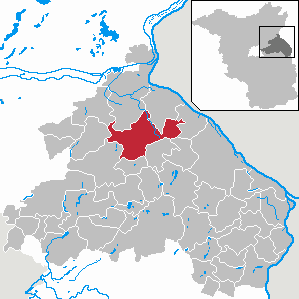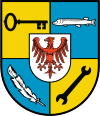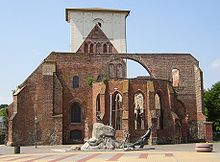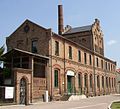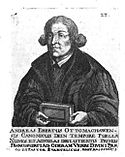Spices
| coat of arms | Germany map | |
|---|---|---|
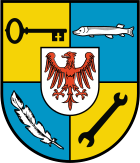
|
Coordinates: 52 ° 43 ' N , 14 ° 8' E |
|
| Basic data | ||
| State : | Brandenburg | |
| County : | Märkisch-Oderland | |
| Height : | 10 m above sea level NHN | |
| Area : | 95.15 km 2 | |
| Residents: | 7174 (Dec. 31, 2019) | |
| Population density : | 75 inhabitants per km 2 | |
| Postal code : | 16269 | |
| Area code : | 033456 | |
| License plate : | MOL, FRW, SEE, SRB | |
| Community key : | 12 0 64 512 | |
| LOCODE : | DE RZE | |
| City structure: | 8 districts | |
City administration address : |
Freienwalder Strasse 50 16269 Wriezen |
|
| Website : | ||
| Mayor : | Karsten Ilm ( CDU ) | |
| Location of the city of Wriezen in the Märkisch-Oderland district | ||
Wriezen [ ˈvʀiːʦn̩ ] (in the 19th century Wrietzen ) is a town in the district of Märkisch-Oderland in the state of Brandenburg .
geography
The city is located on the western edge of the Oderbruch on the Alte Oder in the Brandenburg district of Märkisch-Oderland. The urban area includes parts of the low-lying flat Oderbruch as well as the hilly plateau of the Oberbarnim . Between and on the slopes that descend into the Oderbruch are the Wriezener Terraces and the species-rich Wriezener dry grass border , whose importance for nature conservation has recently received increasing attention. The city center, located directly on the Oder River before the drainage , is now 11 km as the crow flies from the Oder and thus from the German-Polish border. Despite this distance, Wriezen was repeatedly hit by flood disasters on the Oder .
Neighboring communities in the north are Bad Freienwalde (Oder) and Oderaue , in the east Neulewin and Neutrebbin and in the south Bliesdorf and Reichenow-Möglin . To the west, Prötzel , Höhenland and Falkenberg border the Wriezen city area.
City structure
According to its main statute, the city is divided into the following local and community parts:
| view |
|
||||||||
|---|---|---|---|---|---|---|---|---|---|
| Districts | Wriezen (core city) | Altwriezen / Beauregard | Biesdorf | Eichwerder | Frankenfelde | Haselberg | Ludersdorf | Rathsdorf | Schulzendorf |
| Parish parts | Altwriezen , Beauregard | Biesdorf, Franzenshof | Eichwerder, Jäckelsbruch , Thöringswerder | Haselberg, Radikow | Landhof, Lüdersdorf, Mariannenhof | Altgaul , Neugaul, Rathsdorf | Marienberg, Schulzendorf | ||
| Living spaces | Altkietz, Altwriezener Loose, Frankfurter Vorstadt, Homburgshöhe, Kleine Mühle | Biesdorf settlement | |||||||
| Population (1910) | 7,547 | 696 | 226 | 499 | 215 | 207 | 296 | 471 | 310 |
| Population (1939) | 7,746 | 613 | - | 383 | 260 | 226 | 488 | 431 | 431 |
| Residents (1971) | 6,286 | 526 | 155 | 478 | 252 | 298 | 398 | 380 | 404 |
| Population (1996) | 6,484 | 332 | - | 394 | 173 | 249 | 363 | 300 | 363 |
| Population (2016) | 5,415 | 278 | 139 | 287 | 160 | 261 | 219 | 265 | 331 |
| Population (2019) | 5182 | 294 | 158 | 293 | 168 | 263 | 301 | 262 | 333 |
history
Until the 19th century
Located on the Oder and the road to Stettin , a medieval merchant settlement was established in the 12th century. In the Middle Ages, Wriezen was first mentioned in 1247 as "oppidum wrecene". It is believed that the name was transferred from the former settlement in Altwriezen to the newly founded town. It can be assumed that wrecene refers to the location on the river . In most Slavic languages, “we” means “an” and “recen”, “reka” river ( Lower Sorbian “rěka” (also “rěcka”), Polish “rzeka”, Czech řeka). At that time, Wriezen was right on a large river: the Oder.
The original foundation of the city is not documented. It is known, however, that Emperor Ludwig the Bavarian , whose son Ludwig V (Bavaria) was Margrave of Brandenburg from 1323 to 1351 , granted Wriezen town charter in 1337 . In the 14th century the city developed into the trading center of the Oderbruch and eastern Barnims. Fishing played a major role in this. The city had one of the most important fish markets in the Mark, not least because the fishermen between Oderberg and Küstrin had to offer their fish in Wriezen. In 1438 a “Supreme Court” and, for the first time, a prison and torture chamber were set up in the town hall. Viticulture and brewing have also played an important role in the city since the 16th century.
The Thirty Years' War followed an economic boom , which also brought great devastation in Wriezen. Between 1627 and 1641, the city was sacked by mercenaries almost annually. The imperial as well as the Swedes took turns. In 1631 the Swedish King Gustav II Adolf was in Wriezen. After the war, fewer than 800 remained of the approximately 1200 inhabitants. In addition, severe city fires raged in 1603, 1639 and 1664, so that only 14 houses were preserved after the latter. In 1736 a particularly severe flood followed.
After passing through the Great Elector prompted v. a. economic opening of the Electorate of Brandenburg in 1671, a first so-called protective Jew , Moses Levin, settled in Wriezen in 1677 . In 1730, the local Jews laid their own burial site on today's settlement path, which was not destroyed during the Nazi era and is still maintained today. However, in the November pogroms of 1938, SA men burned down the synagogue built between 1884 and 1886 at Gartenstrasse 48 , which was considered one of the most magnificent in Brandenburg. A small previous building was a church inaugurated in 1820 on Mauerstrasse. Of the 127 inhabitants named Jewish in 1933, none of the city survived after their escape, expulsion and murder .
At the instigation of Frederick II , the course of the Oder and the landscape of the Oderbruch were completely changed between 1747 and 1762 and at the same time the areas gained in the Oderbruch were reclaimed. This led to major changes in the economic structure in Wriezen. The importance of fishing ( pike snatching) and shipping declined sharply. Agriculture, the processing of agricultural products (mills), handicrafts and trade increased in importance, especially because of the population growth in the region as a result of the planned settlement of the Oderbruch. With the establishment of the hook and buckle factory in 1773 and other manufacturers, Wriezen also played a part in the early industrialization.
In 1806 Albrecht Daniel Thaer opened his agricultural college near Wriezen . The local volunteer fire brigade, founded in 1855, is the oldest in the state of Brandenburg today . In 1861 shipping was established, from which the city benefited enormously economically. In 1866 Wriezen was connected to the railway via the Eberswalde - Wriezen branch line . In 1898 the Wriezener Bahn went into operation, which connected the city directly with Berlin and the local Wriezen train station . Until well into the 20th century, the nearby capital Berlin was supplied with vegetables and fish from Wriezen .
Schulzendorf manor, owned by the Pfuels until 1837 (from the Alexander Duncker collection )
Old distillery in Haselberg
20th century
In 1940, on his 40th birthday , the Nazi state sculptor Arno Breker received the former manor Jäckelsbruch in the Eichwerder district as a gift from Adolf Hitler . The donation included not only the palace with its park, but also the entire equipment of the house as well as a new studio built by the architect Friedrich Tamms . In Wriezen itself there had been a large factory site with a siding and canal port since mid-1941 - the stone sculptor workshops Arno Breker GmbH. The stone carving workshops were set up by the general building inspector for Berlin, Albert Speer . The task of the workshops was to carry out sculptural work for the redesign of Berlin and the buildings on the Nazi party rally grounds in Nuremberg . The workshops were continuously expanded in the following years by millions. Towards the end of the war, up to 50 prisoners of war and forced laborers were used to work on the figures. After the Berlin headquarters were destroyed by the task force for the reconstruction of bombed-out cities in November 1943, it was given its new headquarters on the factory premises in the form of barracks.
At the end of the Second World War that put Red Army end of January 1945 as part of the Vistula-Oder Offensive for a quick foray with tanks across the frozen Oder . The "100 tanks from Wriezen" caused a sensation in Berlin; In some cases panicked conditions occurred because the German defense of Berlin was completely surprised and had no troops on hand. The tanks, whose possibility of a coup d'etat on the city was much discussed, had too little fuel and were ordered back due to the general situation. After the major attack by the Red Army from the Oder bridgeheads on April 16, 1945, which led to the Battle of Berlin , Wriezen was hotly contested.
Wriezen fell into Soviet hands on April 19, 1945. The communist resistance fighter Fritz Dornbusch was killed by soldiers of the Red Army who shot into his basement while taking the city. During the GDR era, a memorial stone was dedicated to Dornbusch in the Haselberg district and the legend propagated that Dornbusch intended to surrender Wriezen without a fight and was therefore captured by the SS and shot in the head on April 18, 1945. The council had the memorial stone with the corresponding inscription and the wrong date of death dismantled after 1990.
The city was almost completely destroyed in the fighting and rebuilt in the following decades with considerable changes to the cityscape. The 1947 Oder flood disaster then contributed to the destruction, which also severely affected the lower-lying parts of the Wriezen city center around the market and train station.
From 1817 until its dissolution in 1952, Wriezen was part of the Oberbarnim district, Potsdam administrative district . The city then belonged to the newly formed Bad Freienwalde district in the Frankfurt (Oder) district in the GDR until 1990 . From 1992 to 1997 the city was the seat of the Wriezen office . The town has been the seat of the administrative office of the Barnim-Oderbruch office, which almost encloses Wriezen, since 1992 (until the Wriezen-Land office was renamed in 1994).
Incorporations
The city of Wriezen was enlarged by four former municipalities at the end of 1997. At the same time, the new municipality of Wriezener Höhe was formed from three previously independent municipalities. In October 2003 the municipality of Wriezener Höhe was incorporated into the city of Wriezen.
Previous parish mergers took place in 1957, 1959, and 1974.
| Former parish | date | annotation |
|---|---|---|
| Altwriezen | January 1, 1957 | Merger with Beauregard to Altwriezen / Beauregard |
| Altwriezen / Beauregard | December 31, 1997 | |
| Beauregard | January 1, 1957 | Merger with Altwriezen to Altwriezen / Beauregard |
| Biesdorf | 1st January 1974 | Merger with Lüdersdorf to Lüdersdorf / Biesdorf |
| Eichwerder | December 31, 1997 | |
| Frankenfelde | December 31, 1997 | Incorporation after Wriezener Höhe |
| Haselberg | December 31, 1997 | Incorporation after Wriezener Höhe |
| Ludersdorf | 1st January 1974 | Merger with Biesdorf to Lüdersdorf / Biesdorf |
| Lüdersdorf / Biesdorf | December 31, 1997 | Incorporation after Wriezener Höhe |
| Neugaul | April 1, 1959 | Merger with Rathsdorf to Rathsdorf / Neugaul |
| Rathsdorf | April 1, 1959 | Merger with Neugaul to Rathsdorf / Neugaul |
| Rathsdorf / Neugaul | December 31, 1997 | |
| Schulzendorf | December 31, 1997 | |
| Wriezener Höhe | October 26, 2003 |
Population development
|
|
|
|
|
Territory of the respective year, number of inhabitants: as of December 31 (from 1991), from 2011 based on the 2011 census
religion
The majority of the population of Wriezen is not affiliated with any denomination.
There are also traditionally Protestant congregations. These gather in the Protestant Church of St. Mary as well as in the various village churches of the districts. The Johanniter grammar school is also evangelical.
There is also a small Catholic parish in town, which gathers in the Church of St. Laurentius, consecrated in 1913.
Until the time of National Socialism, Wriezen was a place of Jewish life for over 200 years. A memorial stone commemorates the destroyed synagogue. The Jewish cemetery , laid out in 1730, has been preserved.
politics
City Council
The city council of Wriezen consists of 18 members and the full-time mayor.
| Party / group of voters | Seats |
|---|---|
| AfD | 5 |
| FDP | 4th |
| Voting group "Citizens for Wriezen and Barnim Oderbruch" | 3 |
| CDU | 3 |
| Alliance 90 / The Greens | 1 |
| SPD | 1 |
| Independent voter community | 1 |
(As of: local election on May 26, 2019 )
mayor
- 1989–2017: Uwe Siebert (independent)
- since 2017: Karsten Ilm (CDU)
Ilm was elected for a term of eight years on September 24, 2017 with 63.4% of the valid votes.
coat of arms
Blazon : “Square of gold and blue covered with a silver heart shield, inside a red eagle; above in front a lying black key, above in back a silver fish; a silver feather at the lower front; a black wrench on the lower left at an angle. "
The coat of arms was approved on June 30, 1992.
The historic city coat of arms showed the red eagle on a white background, similar to the one inside the current coat of arms. This represents an extension of the historical coat of arms, by adding the city colors yellow and blue covered with symbols such as B. the pike, which stands for the earlier pike-tearing.
flag
The flag of the city consists of the colors yellow and blue, each with two quarters of a color offset.
Town twinning
The city of Wriezen maintains the following city partnerships :
![]() Mieszkowice , (Bärwalde in der Neumark), Poland Hachiōji , Japan
Mieszkowice , (Bärwalde in der Neumark), Poland Hachiōji , Japan
![]()
Sights and culture
To commemorate the flood of the Oder in 1997 , the dike festival is celebrated annually.
Buildings
- The St. Mary's Church , a late Gothic brick hall church with an extension on the south side and a low polygonal choir closure from the 2nd half of the 15th and 1st quarter of the 16th century, was built using parts of a previous building from the 13th century built. The tower was baroque in the 18th century and given a French dome . The church was badly damaged in April 1945 and has been in ruins ever since. The south aisle was partially rebuilt in 1951 and has been used for worship services ever since. The tower was restored in the 1990s and provided with a flat emergency roof, the preparatory work for the reconstruction of the church under the leadership of a support association has begun. During excavations in November 2000 at St. Mary's Church, 17 large plastic bags of unsorted stray bones were recovered, which, due to their composition of mainly skulls and long bones , were interpreted as the remains of a medieval ossuary . In 2001 the bones were anthropologically examined at the Free University of Berlin . 36 skulls were almost completely present. From the left tibia, 84 adults and eight children could be identified, most of them male. Most adults died of old age. The average height was to be assessed rather small at 161.5 cm. A low exposure to dental caries suggested a low-sugar diet with moderate meat consumption.
- The Catholic St. Laurentius Church was built in 1912/1913 in neo-Romanesque style with Art Nouveau elements and was inaugurated on September 21, 1913.
- Gallery “Zur alten Malzfabrik”: The building was built in 1858 as a malt factory and since 1997 has housed the Wriezen City Museum, the Humpensaal and the gallery.
- Stadtsparkasse building: The imposing building was originally built in 1781 by the Royal Chamber Councilor Friedrich Wilhelm Noeldechen as a silk building in the Baroque style and later converted into a residential building. It housed the Prussian King Friedrich Wilhelm III. on the run after the lost battle near Jena and Auerstedt and was used during the French occupation as a commandant's office, later a military music school and since the beginning of May 1922 as a district bank building. Today a branch of the Sparkasse Märkisch-Oderland is located in this building.
- Former Taubstummenanstalt, now home to the town hall of the city is
- Old Port of Wriezen: The Wriezener Hafen was built in 1902 on the Alte Oder. With a 300 meter long quay, it offered berths for barges according to Finow size . Building materials, petroleum, fertilizers and grain as well as hard coal and lime were transported. Port operations were stopped in 1969 and the port basin was partially filled in. Since 2006 an interest group Hafen Wriezen has been trying to renovate the historical ensemble and make it accessible to the public. The historic lime kilns on the port area from the years 1860 (setting furnace) and 1889 (blast furnace) are currently being renovated with donations and voluntary work.
- Market fountain: created by the sculptor Horst Engelhardt from the Eichwerder district. With its many provocative details, the fountain has caused a sensation across the region.
- Market fountain at the Marienkirche
- Monument to Albert Mahler (1819–1894): The monument on Schützenplatz was erected in 1895 for the mayor and founder of the first volunteer fire brigade in Brandenburg.
- Jewish cemetery : The listed Jewish cemetery was laid out in 1730 far outside the city. With 1630 square meters it is the largest surviving Jewish burial place in the Oder region with 132 tombstones. As part of the project Jewish cemeteries in Brandenburg (Jewish studies, University of Potsdam), the Jewish cemetery Wriezen was documented in a freely accessible online database.
- Mountain cemetery with grave monuments and gravestones from the 18th and 19th centuries Century. The monumental war memorial for the fallen soldiers of the First World War is well worth seeing .
- Memorial stone from 1949 by the sculptor Bibach in the cemetery to the left of the chapel for the three anti-fascist resistance fighters Wilhelm Hirchert, Fritz Dornbusch and Bruno Moses, who were murdered in the Sachsenhausen and Auschwitz concentration camps
- Memorial plaque for Fritz Dornbusch in the vestibule of the school named after him in GDR times at Freienwalder Strasse 1, which was removed after 1991, as was the memorial stone in nearby Haselberg
- Game enclosure: Roe deer, fallow deer, mouflon and wild boar have been kept in gates on a 10 hectare area on the northwestern outskirts of the city. The small number of items in the spacious enclosures guarantees an undisturbed course of the game's active times in the natural environment.
museum
- Wriezen City Museum
Movie
- After Wriezen (documentary 2012)
Economy and Infrastructure
The construction company Märkische Ingenieur Bau GmbH, the correctional facility Wriezen and the hospital Märkisch-Oderland GmbH are among the largest employers. The city is the seat of the administrative office of the Barnim-Oderbruch Office .
traffic
The federal road 167 between Bad Freienwalde and Seelow and the state road L 33 between Strausberg and Letschin cross the city. The closest motorway junctions are Finowfurt on the federal motorway 11 and Berlin-Hohenschönhausen on the federal motorway 10 (eastern Berlin ring).
The Wriezener Bahn ran from Berlin Wriezener Bahnhof to Wriezen. From 1892, the Wriezen – Jädickendorf railway line extended to the east across the Oder and into the Neumark . Since 2006, the Berlin – Wriezen line has only been operated as far as Werneuchen . Wriezen station is located on the Eberswalde – Frankfurt (Oder) railway line, which opened in 1866 and was completed in 1877 . It is served by the regional train line RB 60 Eberswalde - Frankfurt (Oder) .
Wriezen is on the Tour Brandenburg long-distance cycle route
education
In the city there is the elementary and high school "Salvador Allende".
The Evangelisches Johanniter-Gymnasium was opened in the 2007/08 school year. Until then, the Oderbruch grammar school "Leonhard Euler" existed in the same place, which was named after the communist Fritz Dornbusch, who was murdered in 1945, in the GDR before the fall of the Wall .
Wriezen also has a small city library.
Personalities
Honorary citizen
- 1994: Nobutsugu Koenuma (1908–1946), Japanese doctor
- 1996: Michael Succow (* 1941), biologist and agricultural scientist, honorary citizen of the former municipality of Lüdersdorf / Biesdorf, now the district of Wriezens
- 2003: Hartmut Meyer (* 1943), 1993 to 2003 Minister for Urban Development, Housing and Transport of the State of Brandenburg
- 2006: Peter Hanke (* 1941), city councilor and chairman of the city council assembly
- 2014: Peter Fuhge (1941–2018), head of the school in Lüdersdorf, Mayor of Wriezener Höhe, Mayor of Haselberg
sons and daughters of the town
- Gottlob Mathias von Borcke (1717–1797), major general
- Samuel Bleichröder (1779–1855), founder of an important financial empire that achieved world renown under his son Gerson Bleichröder
- August Leopold Crelle (1780–1855), Prussian senior building officer, founder of the journal for pure and applied mathematics, born in Eichwerder
- August Reinhold Kaiser (1805–1874), Prussian district administrator
- Rudolf von Rabe (1805–1883), Prussian civil servant and minister of state
- Leopold Bornitz (1806–1853), doctor and writer
- Eduard Grawert (1808–1864), painter
- Bernhard Kuntze (1814–1899), manor owner, born in Eichwerder
- Wilhelm von Ploetz (1825–1885), Lieutenant General
- Albrecht Conrad Thaer (1828–1906), agricultural scientist, born in Lüdersdorf
- Otto von Hoffmann (1833–1905), administrative lawyer and President of the Reich Debt Administration
- Emil Steinweg (1836–1921), writer
- Herman Schnetzky (1850–1916), German-American architect of important buildings in Wisconsin
- Carl Pietzner (1853–1927), kuk court and chamber photographer
- Karl Dammköhler (1856–1909), researcher and traveling salesman
- Emil Vogel (1859–1906), music history researcher
- Otto Schulze (1868–1941), hydraulic engineer and university professor, rector of the university and senator of the Free City of Danzig
- Fritz Müntner (1870–1934), trade unionist
- Otto Werner (1885–1954), architect
- Konrad Karl Richard Müller (1891–1978), painter and globetrotter
- Robert Herlth (1893–1962), film architect
- Martin Schmidt (1894–1964), cycling coach
- Kurt Herlth (1896–1966), production designer
- Karl Francioh (1912–1945), SS member, convicted and executed war criminal
- Willi Kimmritz (1912–1950), criminal, murderer
- Horst Krockert (1924-2015), politician (SPD)
- Erwin Ross (1926–2010), painter in the entertainment district of Hamburg-St. Pauli ("Rubens of St. Pauli")
- Erich Ahrendt (1933–2009), javelin thrower
- Manfred Dambroth (1935–1994), crop scientist
- Gert Hartmann (1935–2016), Protestant theologian, author
- Dieter Noeske (* 1936), organ builder
- Erika Stürmer-Alex (* 1938), graphic artist and painter
- Michael Succow (* 1941), biologist and agricultural scientist, born in Lüdersdorf
- Henning von Boehmer (* 1943), business lawyer, former Secretary General of the International Chamber of Commerce
- Cornelia Froboess (* 1943), actress and pop singer
- Jörg-Detlef Kühne (* 1943), lawyer and university lecturer
- Martin Herche (* 1953), theologian, general superintendent for the Görlitz district of the Evangelical Church Berlin-Brandenburg-Silesian Upper Lusatia
- Carmen Winter (* 1963), writer and poet
- Holger Wulschner (* 1963), show jumper
- Kerstin Jentzsch (* 1964), journalist and writer
- Dorothé Reinoss (* 1966), actress
- Alfrun Kliems (* 1969), Slavist and university professor
- Axel Anklam (* 1971), visual artist
- Sebastian Scheel (* 1975), politician (Die Linke)
- Kristy Augustin (* 1979), politician (CDU), member of the Brandenburg state parliament
- Martin Sauer (* 1982), rower
- Tobias Moeck (* 1984), musician, radio news anchor
- Norbert Müller (* 1986), politician (Die Linke), Member of the Bundestag
Personalities associated with Wriezen
- Ludwig IV (HRR) (1282 / 1286–1347), Roman-German king and emperor, granted Wriezen city rights in 1337
- Andreas Ebertus (1479–1557), Lutheran theologian and pastor in Wriezen
- Johann Daniel Gohl (1674–1731), district doctor in Wriezen
- Otto Balthasar von Thun (1721–1793), Prussian lieutenant general, canon in Halberstadt, lived and died in Wriezen (monument)
- Franz Körte (1782–1845), natural and agricultural scientist, worked at the Agricultural Academy in Möglin , lived and died in Lüdersdorf
- Michael Moritz Eulenburg (1811–1887), orthopedic surgeon, grew up in Wriezen
- Rudolf Schmidt (1875–1943), journalist, local researcher and regional historian, author of the "Description of the City of Wriezen"
- Sibylle Klefinghaus (* 1949), writer, lives in Wriezen
- Horst Engelhardt (1951–2014), sculptor, lived and worked in Eichwerder
- Ingrid Köppe (* 1958), GDR civil rights activist, lives in Wriezen
- Nadeshda Brennicke (* 1973), actress, lives in Wriezen
literature
in alphabetical order by authors / editors
- Historical local lexicon for Brandenburg - Part VI - Barnim . Edited by Lieselott Enders with the assistance of Margot Beck. In: Klaus Neitmann (Hrsg.): Publications of the Brandenburg State Main Archives (Potsdam State Archives) - Volume 16 . Founded by Friedrich Beck . Publishing house Klaus-D. Becker, Potsdam 2011, ISBN 978-3-941919-83-9 , pp. 639 ff .
- Brigitte Heidenhain: Jews in Wriezen. Her life in the city from 1677 to 1940 and her cemetery. Universitätsverlag, Potsdam 2007, ISBN 978-3-939469-39-1 ( full text ).
- Jörg Kritzler: History of the city of Wriezen - a chronological overview. Findling-Verlag, Kunersdorf 2008, ISBN 978-3-933603-44-9 .
- Ilona Rohowski: Monument topography Federal Republic of Germany . Monuments in Brandenburg. District of Märkisch-Oderland 9.1 = towns of Bad Freienwalde and Wriezen, villages in Niederoderbruch. Wernersche Verlagsgesellschaft , Worms 2006, ISBN 978-3-88462-230-8 .
- Wriezen - gateway to the Oderbruch. Illustrated book. Geiger-Verlag, Horb am Neckar 1994, ISBN 3-89264-920-0 .
- Carl Wulff: Wriezen on the Oder in old views. European Library, Zalthommel / Netherlands 1992, ISBN 90-288-2054-X .
Web links
Individual evidence
- ↑ Population in the State of Brandenburg according to municipalities, offices and municipalities not subject to official registration on December 31, 2019 (XLSX file; 223 KB) (updated official population figures) ( help on this ).
- ↑ Thaer today . (PDF) Volume 6, Möglin 2009, p. 121.
- ↑ Wriezen dry grassland . ( Memento from August 25, 2014 in the web archive archive.today ) Stiftung Naturschutzfonds Brandenburg, 2012
- ↑ Oderbruch capital Wriezen, districts
- ^ Service portal of the state administration Brandenburg. City of Wriezen
- ↑ Historical municipality register of the State of Brandenburg 1875 to 2005. Landkreis Märkisch-Oderland (PDF), pp. 34–37.
- ↑ Population in the state of Brandenburg by urban districts, districts and municipalities 1991 to 2014 ( Memento from April 2, 2015 in the Internet Archive ) (PDF)
- ↑ Including the then still independent Alt Kietz.
- ↑ a b No individual data, Biesdorf was then part of the Lüdersdorf community.
- ↑ a b No individual data, Biesdorf was then part of the Lüdersdorf / Biesdorf community
- ↑ Christian Samuel Ulrich: Description of the city of Wriezen and its surroundings, in historical-statistical-topographical relation . Berlin 1830, pp. 14-16.
- ↑ Christian Samuel Ulrich: Description of the city of Wriezen and its surroundings, in historical-statistical-topographical relation . Berlin 1830, p. 21.
- ↑ a b c d Brigitte Heidenhain: Jews in Wriezen, their life in the city from 1677 to 1940 and their cemetery . University Press, Potsdam 2007.
- ↑ Christian Samuel Ulrich: Description of the city of Wriezen and its surroundings, in historical-statistical-topographical relation . Berlin 1830.
- ↑ Märkische Oderzeitung , September 19, 2005, p. 10.
- ↑ In detail in: Peter Gosztony (Ed.): The battle for Berlin in eyewitness reports . Deutscher Taschenbuch Verlag, Munich 1985, ISBN 3-423-02718-5 , p. 49 ff.
- ^ Annette Leo : Blurred contours - sharp competition . In: Gedenkstättenrundbrief , 131, pp. 27–33.
- ↑ Changes in the municipalities of Germany, see 1997 StBA
- ↑ Changes in the municipalities in Germany, see 2003 StBA
- ↑ Municipalities in 1994 and their changes since January 1st, 1948 in the new federal states . Metzler-Poeschel, Stuttgart 1995, ISBN 3-8246-0321-7 , publisher: Federal Statistical Office
- ^ Historical municipality register of the state of Brandenburg 1875 to 2005. Landkreis Märkisch-Oderland . Pp. 34-37
- ↑ Population in the state of Brandenburg from 1991 to 2015 according to independent cities, districts and municipalities , Table 7
- ^ Office for Statistics Berlin-Brandenburg (Ed.): Statistical report AI 7, A II 3, A III 3. Population development and population status in the state of Brandenburg (respective editions of the month of December)
- ^ Result of the local election on May 26, 2019
- ↑ A forgotten informant. In: Märkische Onlinezeitung , February 20, 2012
- ↑ Local elections October 26, 2003. Mayoral elections , p. 26
- ^ Result of the mayoral election on September 27, 2009
- ↑ Coat of arms information on the service portal of the state administration of Brandenburg
- ↑ Friendship reaffirmed. In: Märkische Onlinezeitung , July 12, 2017
- ^ Project Wriezen, former ossuary. In: anthropologie-jungklaus.de. Retrieved June 4, 2017 .
- ↑ Bettina Jungklaus , Blandine Wittkopp : “Memento Mori” at the entrance. A bone store at the Marienkirche in Wriezen, Märkisch-Oderland district . In: Archeology in Berlin and Brandenburg 2001 . Konrad Theiss Verlag in commission, Stuttgart 2002, ISBN 978-3-8062-1784-1 , p. 145-146 .
- ↑ Old Port. Interest group Hafen Wriezen e. V.
- ↑ Jewish Cemetery in Wriezen Online database of the University of Potsdam, accessed on May 14, 2017.
- ^ Hospital Märkisch-Oderland
- ↑ Ev. Johanniter-Gymnasium Wriezen
- ^ Schools in MOL , accessed June 25, 2011
- ↑ Silent memory of Dr. Koyenuma. In: Märkische Onlinezeitung, March 9, 2009
- ↑ a b Honorary Citizen of the City of Wriezen ( Memento of the original from June 21, 2017 in the Internet Archive ) Info: The archive link was inserted automatically and has not yet been checked. Please check the original and archive link according to the instructions and then remove this notice. at www.wriezen.de
- ↑ Fritz Müntner in: digital library of the Friedrich Ebert Foundation
- ^ Biography Horst Engelhardt

